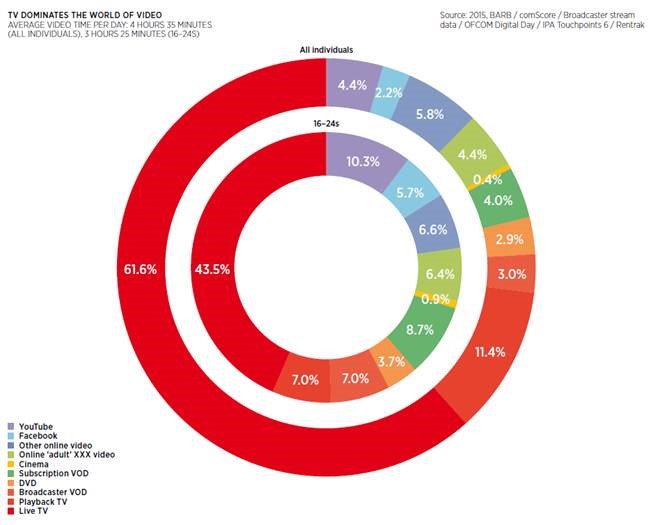TV accounts for 76% of UK video consumption

Of that, on average three hours and 47 minutes was watched on a TV set and four minutes was watched on other devices such as tablets, smartphones and laptops.
The 16- to 24-year-old aged group is the one with the most dramatic changes in viewing: they watched an average of two hours and 24 minutes a day of TV in 2015, of which two hours and 14 minutes was on a TV set and 10 minutes was on other devices. The represents a decline of 7% on 2014 and 8% down on 2005.
Thinkbox data now looks at all TV viewing. Previously it only covered viewing on a TV set within seven days of the original broadcast (as measured by BARB) combined with streaming data from broadcasters for other devices. But as TV viewing increasingly falls outside standard measurement (in 2015 it was estimated to account for 6.5% of all TV viewing) it has broadened its analysis.
So overall, TV – covering live, playback or on-demand across all screens – had a 76% share of total video viewing in 2015. This is down from 81% in 2014, although Thinkbox points to an increase in the overall amount of video being watched.
According to its analysis of video viewing – combining comScore with BARB data, Broadcaster VOD stream data, Rentrak box office numbers and calibrating this metered/census level data with the IPA’s Touchpoints study – the total amount of video the UK is watching has increased. In 2015, the average person in the UK watched 4 hours, 35 minutes a day of video in all its different forms, an increase of 15 minutes a day since 2014.
YouTube accounts for 4.4% of video ( 3.5% in 2014 ); online ‘adult’ video is 4.4% of total video; subscription video on demand (SVOD) such as Netflix and Amazon Prime accounted for 4% (up from 2.3% in 2014 ); Facebook was 2.2%; and all other online video (Vimeo, newspaper websites etc) was 5.8% of total video in 2015.

Lindsey Clay, Thinkbox CEO, said: “TV has expanded in recent years into new times and places; the way we watch TV is changing. We need to show as accurate a picture as possible of how much TV we are watching – and where TV sits in the emerging video world. These new figures show that TV dominates the video world for all age groups. Today’s young people watch on-demand forms of video more than the generations before.
"This makes sense as they do not tend to have control of the TV set and so turn to their personal screens to watch what they want. What is remarkable is that in the last decade, when so many new technologies and services have arrived that could have disrupted TV, TV viewing has remained so dominant.”

We hope you enjoyed this article.
Research Live is published by MRS.
The Market Research Society (MRS) exists to promote and protect the research sector, showcasing how research delivers impact for businesses and government.
Members of MRS enjoy many benefits including tailoured policy guidance, discounts on training and conferences, and access to member-only content.
For example, there's an archive of winning case studies from over a decade of MRS Awards.
Find out more about the benefits of joining MRS here.














0 Comments